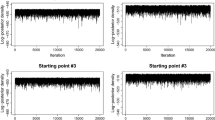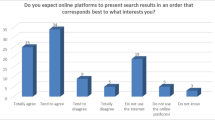Abstract
In this paper, we propose a (n−1)2 parameter, multistage ranking model, which represents a generalization of Luce's model. We propose then×n item-rank relative frequency matrix (p-matrix) as a device for summarizing a set of rankings. As an alternative to the traditional maximum likelihood estimation, for the proposed model we suggest a method which estimates the parameters from thep-matrix. An illustrative numerical example is given. The proposed model and its differences from Luce's model are briefly discussed. We also show some specialp-matrix patterns possessed by the Thurstonian models and distance-based models.
Similar content being viewed by others
References
Babington-Smith, B. (1950). Discussion of Professor Ross' paper.Journal of the Royal Statistical Society, Series B, 12, 153–162.
Bradley, R. A., & Terry, M. E. (1952). Rank analysis of incomplete block designs.Biometrika, 39, 324–335.
Critchlow, D. E., Fligner, M. A., & Verducci, J. S. (1991). Probability models on Rankings.Journal of Mathematical Psychology, 35, 294–318.
Daniels, H. E. (1950). Rank correlation and population models.Journal of the Royal Statistical Society, Series B, 171.
Diaconis, P. (1988).Group representations in probability and statistics. Hayward: Institute of Mathematical Statistics.
Fligner, M. A., & Verducci, J. S. (1986). Distance based ranking models.Journal of the Royal Statistical Society, Series B, 48, 359–369.
Friedman, M (1940). A comparison of alternative tests of significance for the problem ofm rankings.Annuals of Mathematical Statistics, 11, 86.
Kendall, M. G. (1948).Rank correlation methods. London: Charles Griffin and Co.
Kendall, M. G. (1950). Discussion on symposium on ranking methods.Journal of the Royal Statistical Society, Series B, 12, 189.
Luce, R. D. (1959).Individual choice behavior. New York: John Wiley.
Mallows, C. L. (1957). Non-null ranking models. I.Biometrika, 44, 114–130.
Mosteller, F. (1951). Remarks on the method of paired comparisons, I: The least squares solution assuming equal standard deviations and equal correlations.Psychometrika, 16, 3–9.
Schucany, W. R. & Frawley, W. H. (1973). A rank test for two group concordance.Psychometrika, 38, 249–258.
Spearman, C. (1904). The proof and measurement of association between two things.American Journal of Psychology, 15, 88.
Thurstone, L. L. (1927). A law of comparative judgment.Psychological Review, 34, 273–286.
Yellott, J.I., Jr. (1977). The relationship between Luce's choice axiom, Thurstone's theory of comparative judgment, and the double exponential distribution.Journal of Mathematical Psychology, 15, 109–144.
Author information
Authors and Affiliations
Corresponding author
Rights and permissions
About this article
Cite this article
Liqun, X. A multistage ranking model. Psychometrika 65, 217–231 (2000). https://doi.org/10.1007/BF02294375
Received:
Revised:
Issue Date:
DOI: https://doi.org/10.1007/BF02294375




